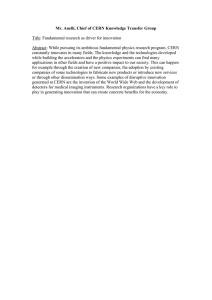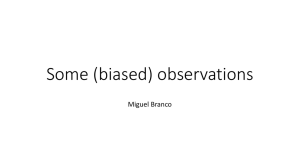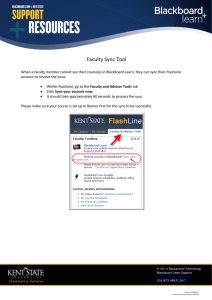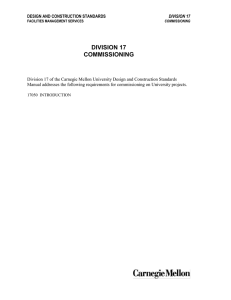A brief Summary on Synchronization Strategies in the Muon System
advertisement
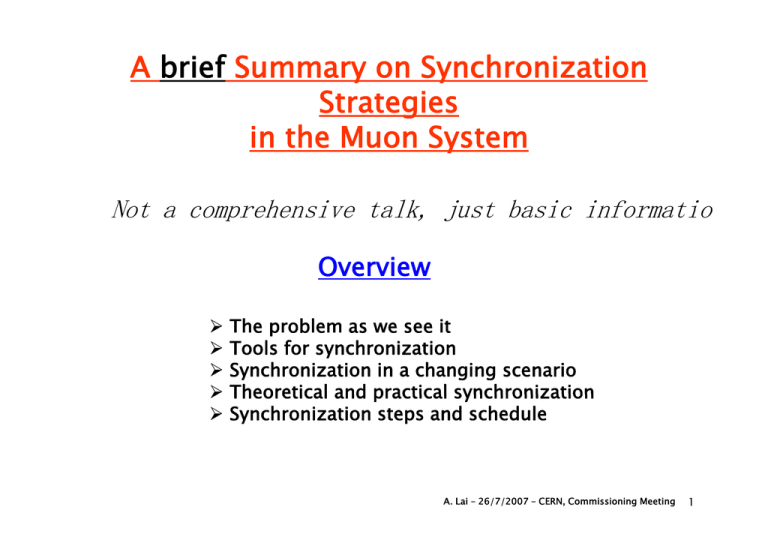
A brief Summary on Synchronization Strategies in the Muon System y Not a comprehensive talk, talk just basic informatio Overview ¾ ¾ ¾ ¾ ¾ The ep problem ob e as we e see itt Tools for synchronization Synchronization in a changing scenario Theoretical and practical synchronization Synchronization steps and schedule A. Lai – 26/7/2007 – CERN, Commissioning Meeting 1 Synchronization: the problem as we see it 1. Synchronizing the Muon System is: a) b) For a given event, align all the hits within one ODE board and give i them h the h SAME Id (relative ( l i alignment) li ) Give the hits the RIGHT Id (absolute alignment). 2 O 2. Owing to the h nature off the h Muon Detector, synchronizing h is also: a) Measuring the time of the hits inside the clock period, building the time spectra and centering them inside the 25 ns window, in order to maximize detection efficiency In our jargon: 1 is called coarse timing, timing, 2 is called fine timing. timing. • Both tasks 1 and 2 are heavily complicated by the complexity of the Muon System connectivity • An automatic calculation of latencies and delays can be useful but does not spare us from measuring and checking the effective delays on detector A. Lai – 26/7/2007 – CERN, Commissioning Meeting 2 System Tools for Synchronization Fine time tuning (DIALOG, on FEE) 1.6 ns x 31 steps (per single channel) Coarse time tuning (SYNC, ODE) Per board (all 192 channels) • TTCrx settings Per SYNC (all 8 channels) • BX offset • BX preload (at BCR) • L0 buffer latency. Per channel: • Pipeline steps to L0 trigger • Pipeline Pi li steps at SYNC inputs i Pulses to FEE inputs Synchronous Sy c o ous to a g given e programmable BC# A. Lai – 26/7/2007 – CERN, Commissioning Meeting 3 SYNC internal dataflow BCR, L0R To L0 triigger Data from FEE preset/get t/ t BC counter via ECS BX tag Start W_Add L0 buffer DPRAM 256 Programmable L0 buffer latency (R/W pointers) Start R_Add L0yes BXId(3:0) L0 derandomizer DPRAM 128 (BCR) To ODE controller t ll A. Lai – 26/7/2007 – CERN, Commissioning Meeting 4 Synchronization: different strategies for different scenarios 1. On the ODE we have the possibility to measure directly the local time difference with respect to the start of the orbit. This would directly yg give the RIGHT BX correction (absolute ( alignment), g ), but requires a “good” event rate Æ not the case in the (long) startup period Æ method to be used as a crosscross-check later. 2. Preparing the pilot run: Calo interaction trigger and multi multi-bunch events. Æ No urgent need now for this setup Æ It will be prepared in time for the beam Present strategy: Use of pulsing system + SYNC features, both at ECS and DAQ level A general comment: We experimented on our own skin how the “real world of connections - O(105)” is different wrt our models. We are now checking all the errors in connectivity (inversions/lacking or defective connections). We still do not know how much the cable length database differs wrt reality (I can say it surely differs a lot !!). A. Lai – 26/7/2007 – CERN, Commissioning Meeting 5 Internal vs global timing Typical scheme of Muon signal flow LVDS cables (can have different lengths) The same FE channel can belong to different logical channels. Inter-channel skew i k is kept b below l 2 ns IB Generation of logical channels (final step) Chambers First logic combinations on DIALOG ODE DAQ only sees logical channels Internal equalization can be done: 1. At DAQ level masking FE channels one by one 2. At ECS level by means of the pulsing system A. Lai – 26/7/2007 – CERN, Commissioning Meeting 6 Synchronization steps foreseen in the present scenario 0. Use the cable length information to calculate an a-priori set of timing parameters: fine time delays on DIALOG and coarse time delays on SYNC. 1. Use the information on the ECS cable length and the pulsing system to align each logical channel (LCH) internally (channel time equalization), as the LCH are made of different combinations of channels. channels Once the INTERNAL LCH components are aligned: 2. Possible pulse runs, acquiring data on DAQ and analyzing them offline (time information generated by SYNC). 3. Optional: track emulation, cosmics ??? (triggering on M3 only, bi-gaps in AND). AND) 4. Same as 2, but with real particles and external trigger (when the beam is on), to take into account also chamber responses. At this level the Calo trigger should enter the game. A dedicated Brunel package is being developed to perform a quick and efficient data analysis oriented to the detailed calculation of DIALOG and SYNC timing parameters. A. Lai – 26/7/2007 – CERN, Commissioning Meeting 7 System Time Alignment SW: previous idea (pilot run oriented) .xml Encoded maps Condition DB BRUNEL algorithm Raw data (multi-bunch events) PCfarm events Ntuples (.root) containing i i connectivity i i attributes as leaves This structure is “circular” if not iterative Time histograms (HW map dependent) Mask k settings (fit dependent) Cable length information This link is optional Histogram fit Delay & mask calculation Muon System Sys configuration PVSS SS HW CU datapoints p Coarse and fine delays + masks k (.txt) (SYNC and DIALOG chip p list) datapoint A. Lai – 26/7/2007 – CERN, Commissioning Meeting 8 New Structure of the System Time Alignment SW .xml Encoded maps Condition DB BRUNEL algorithm Raw data (multi-bunch events) PCfarm events In this case much of the work k iis d done previously i l b by ECS. In principle, the result can be obtained in one go. If more runs are needed they m y are independent Masking should not be necessary Ntuples (.root) containing i i connectivity i i attributes as leaves Time histograms (HW map dependent) Mask k settings (fit dependent) Cable length information Histogram fit Delay & mask calculation Muon System Sys configuration PVSS SS HW CU datapoints p Coarse and fine delays + masks k (.txt) (SYNC and DIALOG chip p list) datapoint A. Lai – 26/7/2007 – CERN, Commissioning Meeting 9 Approximate schedule August: Connectivity tests continue Not later than mid September: Start internal alignment procedures (ECS) in parallel with connectivity tests, tests if not yet concluded concluded. Mid October: Pulse runs and analysis Æ first set of System timing parameters generated. We aim at concluding the alignment by means of pulse runs by the end of the year. Pulse runs are also a complete test of the DAQ chain. A. Lai – 26/7/2007 – CERN, Commissioning Meeting 10
